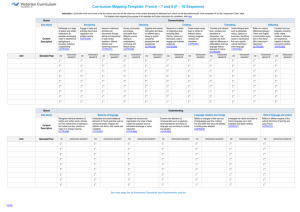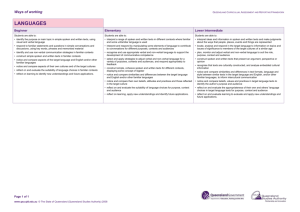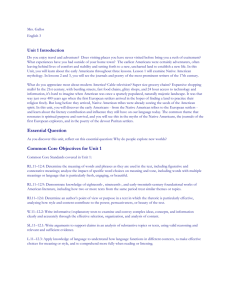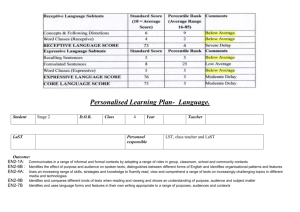Levels 5 and 6 (docx
advertisement
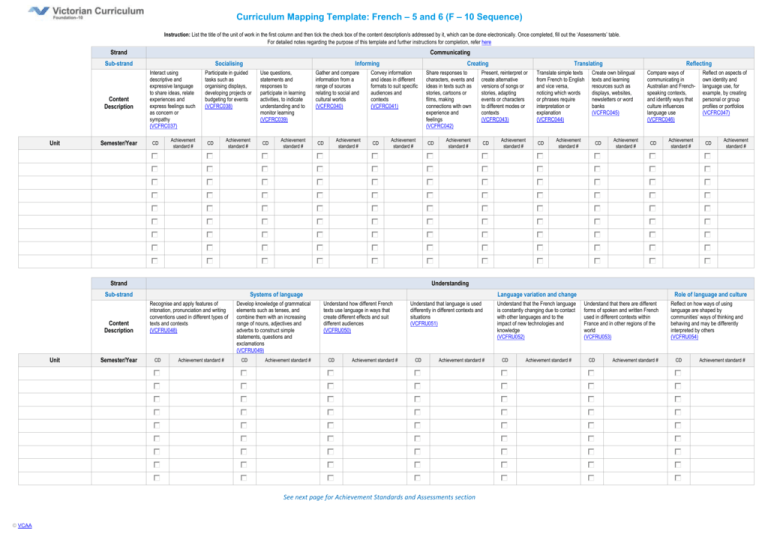
Curriculum Mapping Template: French – 5 and 6 (F – 10 Sequence) Instruction: List the title of the unit of work in the first column and then tick the check box of the content description/s addressed by it, which can be done electronically. Once completed, fill out the ‘Assessments’ table. For detailed notes regarding the purpose of this template and further instructions for completion, refer here Strand Communicating Sub-strand Content Description Unit Semester/Year Socialising Interact using descriptive and expressive language to share ideas, relate experiences and express feelings such as concern or sympathy (VCFRC037) CD Achievement standard # Informing Participate in guided tasks such as organising displays, developing projects or budgeting for events (VCFRC038) CD Achievement standard # Use questions, statements and responses to participate in learning activities, to indicate understanding and to monitor learning (VCFRC039) CD Achievement standard # Gather and compare information from a range of sources relating to social and cultural worlds (VCFRC040) Achievement standard # CD Creating Convey information and ideas in different formats to suit specific audiences and contexts (VCFRC041) CD Achievement standard # Strand Unit Semester/Year CD Achievement standard # CD Systems of language Recognise and apply features of intonation, pronunciation and writing conventions used in different types of texts and contexts (VCFRU048) CD Achievement standard # Develop knowledge of grammatical elements such as tenses, and combine them with an increasing range of nouns, adjectives and adverbs to construct simple statements, questions and exclamations (VCFRU049) Achievement standard # Translate simple texts from French to English and vice versa, noticing which words or phrases require interpretation or explanation (VCFRC044) CD Reflecting Create own bilingual texts and learning resources such as displays, websites, newsletters or word banks (VCFRC045) Achievement standard # CD Achievement standard # Compare ways of communicating in Australian and Frenchspeaking contexts, and identify ways that culture influences language use (VCFRC046) CD CD Achievement standard # Language variation and change Understand how different French texts use language in ways that create different effects and suit different audiences (VCFRU050) CD Achievement standard # Understand that language is used differently in different contexts and situations (VCFRU051) CD Achievement standard # See next page for Achievement Standards and Assessments section © VCAA Translating Present, reinterpret or create alternative versions of songs or stories, adapting events or characters to different modes or contexts (VCFRC043) Achievement standard # Reflect on aspects of own identity and language use, for example, by creating personal or group profiles or portfolios (VCFRC047) CD Achievement standard # Understanding Sub-strand Content Description Share responses to characters, events and ideas in texts such as stories, cartoons or films, making connections with own experience and feelings (VCFRC042) Understand that the French language is constantly changing due to contact with other languages and to the impact of new technologies and knowledge (VCFRU052) CD Achievement standard # Role of language and culture Understand that there are different forms of spoken and written French used in different contexts within France and in other regions of the world (VCFRU053) CD Achievement standard # Reflect on how ways of using language are shaped by communities’ ways of thinking and behaving and may be differently interpreted by others (VCFRU054) CD Achievement standard # Curriculum Mapping Template: French – 5 and 6 Levels 5 and 6 Achievement Standard Levels 3 and 4 Achievement Standard By the end of Level 4 Students interact with teachers and each other through classroom routines, action-related talk and play. They exchange greetings and wishes, respond to familiar instructions and to questions such as Qu’est-ce que c’est? and Qu’est-ce que tu fais? They share simple ideas and information, express positive and negative feelings (Je suis très contente; Je n’aime pas la pluie) and ask for help, clarification and permission. They interpret visual, non-verbal and contextual cues such as intonation, gestures and facial expressions to help make meaning. They make statements using the present tense and present + infinitive form about self, family and interests (Je suis australien et italien; J’habite à Brisbane; Je vais partir demain). They approximate the sounds, rhythms and pitch of spoken French. They comprehend simple, spoken, written, visual and multimodal texts, using cues such as context, graphics, familiar vocabulary and language features. They use modelled sentence structures to compose short original texts such as descriptions, captions or simple narratives, using conjunctions such as et and mais, and prepositions such as sous, sur and devant. They use vocabulary related to familiar contexts and their personal worlds, and apply gender and number agreements in simple constructions (une petite maison, les grands chiens). Students recognise that French is a significant language spoken in many parts of the world, including Australia; that it is similar to English in some ways (the same alphabet and basic sentence structure, many shared words) and different in other ways (use of titles, gestures, some new sounds such as r and u, gender forms). They recognise that languages change over time and influence each other. They identify French words used in English (menu, mousse) and English words used in French (le weekend, stop!). They recognise that language may need to be adjusted to suit different situations and relationships (for example, formal and informal language, different text types). They understand that French has its own rules for pronunciation, non-verbal communication and grammar. They use terms such as verb, adjective and gender for talking about language and learning. Students understand that languages are connected with cultures, and that the French language, like their own, reflects ways of behaving and thinking as well as ways of using language. Separated by line. Number in brackets, e.g. (3), can be used as an identifier in various parts of the template. By the end of Level 6 Students use written and spoken French for classroom interactions and transactions, and to exchange personal ideas, experiences and feelings. (1) They ask and answer questions in complete sentences in familiar contexts (Est-ce que je peux … ? Tu peux..… ?), using appropriate pronunciation, intonation and non-verbal communication strategies. (2) They recognise appropriate forms of address for different audiences, using tu forms with friends and family members, and using vous for teachers and other adults or when more than one person is involved. (3) They gather and compare information from a range of texts. They identify key points and supporting details when reading and listening, and interpret and translate short community texts such as signs or notices. (4) They create connected texts such as descriptions, conversations and picture books, using structured models and processes of drafting and re-drafting. (5) They convey information in different formats to suit specific audiences and contexts. (6) Students use present tense verb forms, conjunctions and connectives (et, mais, parce que, plus tard, maintenant), positive and negative statements (j’ai trois amis, je n’ai plus d’amis), and adverbs such as (très, aussi, beaucoup, un peu and lentement). (7) They recognise and use with support verb forms such as le futur proche (je vais + l’infinitif) and le passé composé (j’ai + regular forms of past participle) as set phrases. (8) They recognise l’imparfait when reading (c’était, il était) but do not yet use it in their own speech or writing. (9) They use possessive pronouns and adjectives with modelling and support, and prepositions to mark time and place (avant, après, devant, derrière). (10) Students recognise differences between spoken and written forms of French, comparing them with English and other known languages. (11) They identify differences in commonly-used text types (for example, greetings, instructions and menus), commenting on differences in language features and text structures.(12) They use metalanguage for language explanation (for example, formal and informal language, body language) and for reflecting on the experience of French language and culture learning. (13) They recognise relationships between parts of words (suffixes, prefixes) and stems of words (préparer, préparation; le marché, le supermarché, l’hypermarché). (14) Students make comparisons between French and their own language and culture, drawing from texts which relate to familiar routines and daily life (la vie scolaire, la famille, les courses, les loisirs, la cuisine). (15) They explain to others French terms and expressions that reflect cultural practices (bon appétit, bonne fête). (16) They reflect on their own cultural identity in light of their experience of learning French, noticing how their ideas and ways of communicating are influenced by their membership of cultural groups. (17) Levels 7 and 8 Achievement Standard By the end of Level 8 Students use written and spoken French to interact with teachers, peers and others and exchange experiences, opinions and views. They use descriptive and expressive language to talk and write about immediate environments, personal interests and feelings and technical language to discuss issues of wider interest (for example, les nouvelles téchnologies, les rapports entre les générations, le travail, la musique). They ask, give and follow directions and instructions, using phrases such as prenez la deuxième rue à gauche ..., suivez le boulevard jusqu’à ... and choisissez la photo. They locate and analyse information from different sources presenting it in modes and formats suitable for the intended audience. They use strategies such as emphasis, repetition and summary to support fluency and expression in shared reading, performances, discussions and debate. They plan, draft and present imaginative, informative and persuasive texts, using simple and compound sentences to structure arguments, and to explain or justify a position. Students use regular verbs in the passé composé form independently as well as high-frequency irregular verbs such as faire, être and avoir. They use declarative, imperative and interrogative verbs in affirmative and negative forms. They interpret and translate language which has colloquial or cultural associations in either French or Australian English, providing alternative expressions when equivalence is not possible (for example, à tout à l’heure, good on ya!). They make appropriate language choices when communicating in French in different contexts and situations. Students use metalanguage to explain language features and elements, using appropriate grammatical terms (tenses, genres, agreement). They identify how language features such as vocabulary, tenor and register serve different purposes in different modes. They make connections between texts and contexts, comparing expression and representation in similar texts from different cultural contexts (for example, invitations to celebrations or ceremonies, postcards or letters between friends). Students identify the relationship between language and culture, understanding that personal and community identity are expressed through cultural expression and language use. They reflect on their own ways of communicating, considering how these might be interpreted by others. Assessments Unit (Title) © VCAA Assessment Achievement Standard/s Unit (Title) Page 2 Assessment Achievement Standard/s
